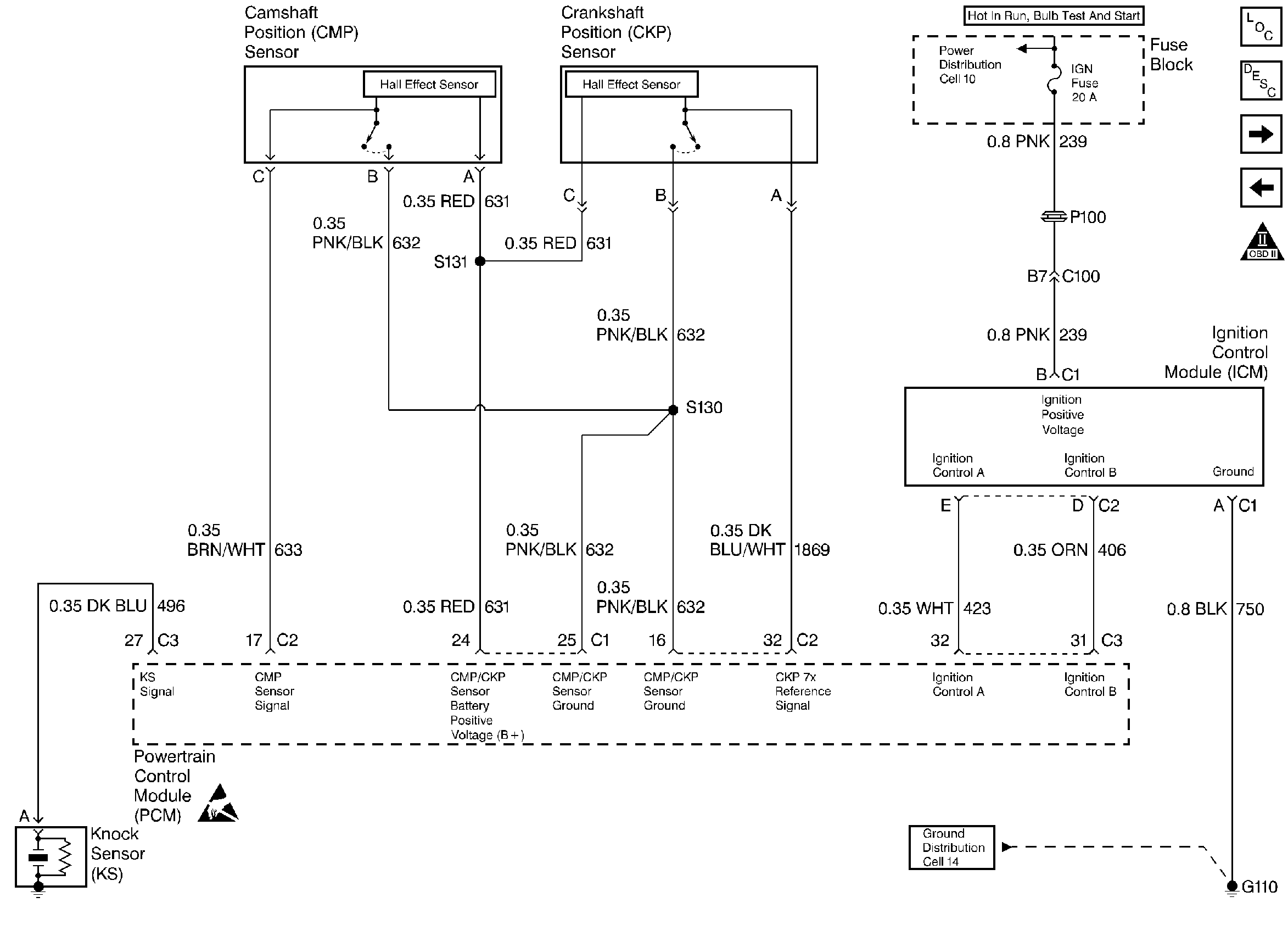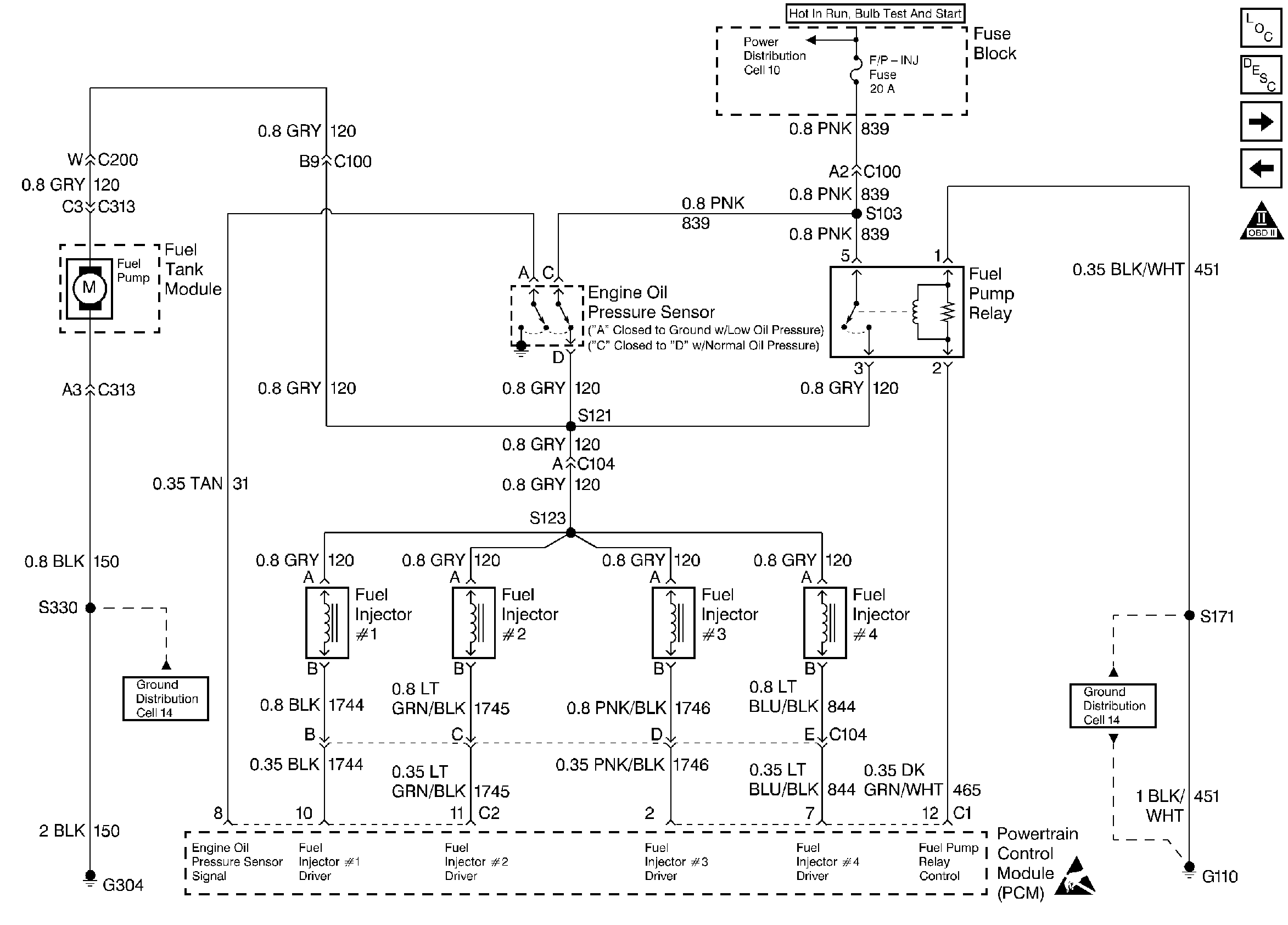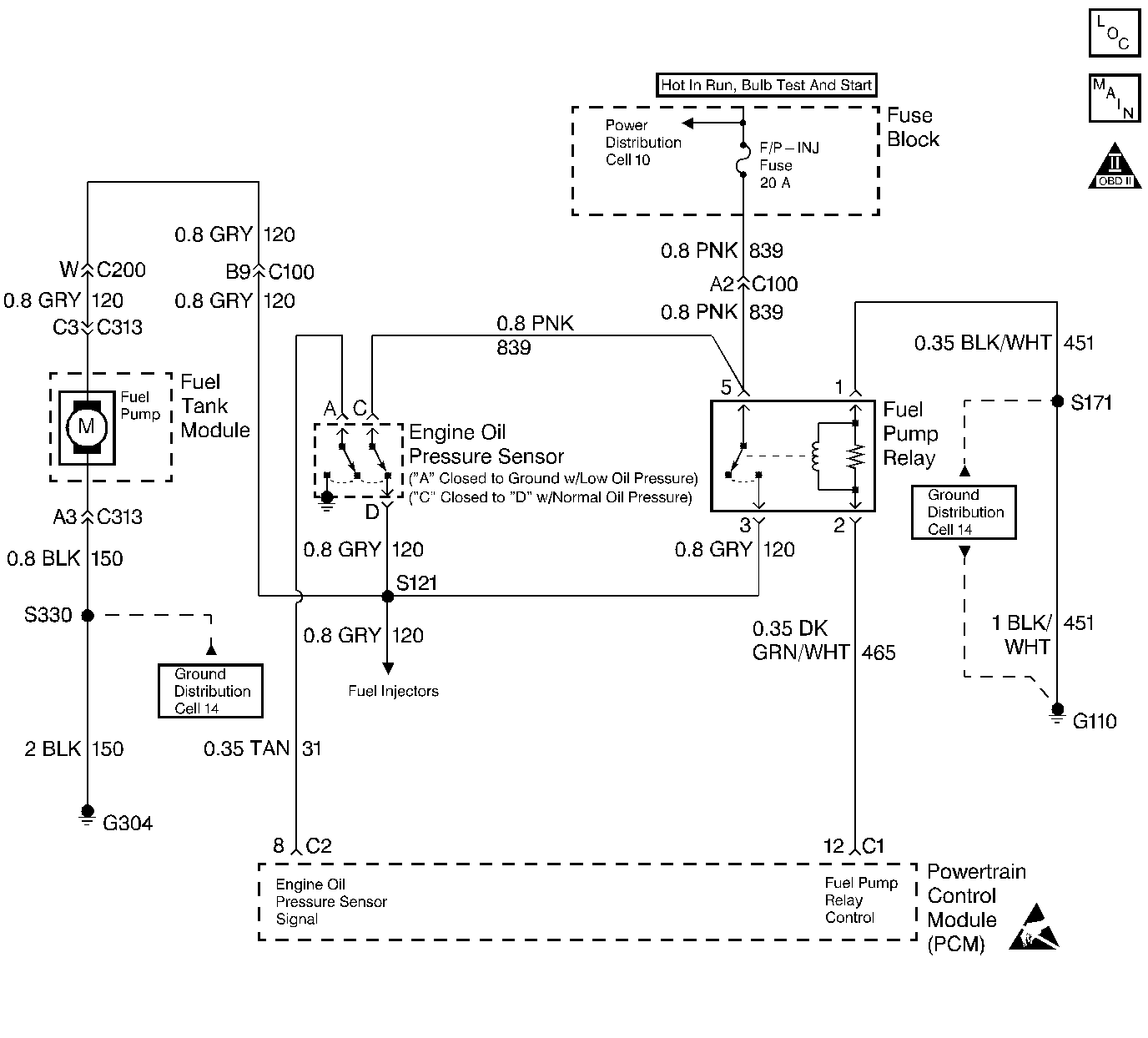Engine Cranks But Does Not Run 2.2L SFI VIN 4
Refer to
Ignition Controls

and
Fuel Controls

for wiring view.
Circuit Description
Important: The Camshaft Position (CMP) Sensor is only used for misfire detection and is not part of the ignition system.
This engine is equipped with a distributorless ignition system called, the Electronic Ignition (EI) system. The primary circuit of the EI system consists of two separate ignition coils, an Electronic Ignition Control Module (ICM) and Crankshaft Position (CKP) sensor as well as the related connecting wires and the ignition control portion of the PCM. Each secondary circuit consists of the secondary winding of the coil, two connecting metal strips are molded into the coil housing, the spark plug boot/connector assemblies and spark plugs.
Diagnostic Aids
| • | A small amount of resistance in the battery positive voltage circuit may cause a no start with a functioning MIL. Check circuit C2-03 for resistance. |
| • | Check the Throttle Position (TP) sensor for binding or sticking or for being intermittently shorted or open. |
| • | If the THEFT SYSTEM telltale is flashing on the Instrument Panel Cluster (IPC), the theft deterrent system has been activated, refer to DTC P1629 Theft Deterrent Fuel Enable Signal Not Received 2.4L, DTC P1629 Theft Deterrent Fuel Enable Signal Not Received 2.2L for further diagnosis. |
| • | Check for water or foreign material in the fuel system. |
| • | Check for a basic engine problem (low compression). |
| • | Verify that only resistor spark plugs are used. |
| • | A scan tool can be used to energize the fuel pump ON to check fuel pump operation and for ignition voltage at the injector harness. |
Test Description
Number(s) below refer to the step number(s) on the Diagnostic Table.
-
The OBD System Check prompts the Technician to complete some basic checks and store the Freeze Frame Data and the Failure records on the scan tool if applicable. This creates an electronic copy of the data taken when the fault occurred. This information on the scan tool can be referred to later.
-
This verifies that the fuel injectors are receiving proper voltage.
-
The fuel pump should be turned ON by the PCM for 2-3 seconds after ignition is first turned ON. Turn the ignition OFF for at least 10 seconds to assure that the PCM powers down. The PCM will then switch the fuel pump back ON. Whenever the fuel pump does not operate, Table A-5 should be used to diagnose the cause.
-
Battery voltage should be available at terminal C of the CKP sensor harness, and terminal B should be a good ground.
-
By grounding the test light to terminal B and B+, ensures the integrity of the ground circuit.
-
The CKP Activity Counter should go to 256 counts, before starting back at 0. At this point it is important that the CKP Activity Counter is incrementing.
-
This verifies a frequency output from the PCM.
-
If ignition control A and ignition control B are shorted together, there will not be a frequency signal. This step determines if ignition control A and ignition control B are shorted together.
-
Thoroughly examine the CKP sensor connector. It should be free of corrosion and contaminants, and pins should be making proper contact.
-
This will verify if the open circuit is in the ICM or the circuit.
Step | Action | Value(s) | Yes | No |
|---|---|---|---|---|
Was the Powertrain On-Board Diagnostic (OBD) System Check performed? | -- | |||
2 | Inspect the PCM ground connection at the engine block. Is the ground connection clean and tight? | -- | ||
3 | Inspect the fuel pump/injector fuse and the ignition fuse. Are the fuses OK? | -- | ||
4 |
Does the TP sensor voltage read less than the specified value? | 1.0V | ||
5 | Is the Engine Coolant Temperature and the Intake Air Temperature close to each other? | -- | Go to DTC P0118 Engine Coolant Temperature (ECT) Sensor Circuit High Voltage | |
6 | Check the Manifold Absolute Pressure (MAP) sensor while cranking the engine. Does the MAP sensor voltage change value while cranking the engine? | -- | ||
Did the test light flash ON and OFF on all the cylinders.? | -- | |||
Is the fuel pressure within the specified value? | 284-325 kPa (41-47 psi) | System OK Refer to Diagnostic Aids | Go to DTC P1441 Evaporative Emission (EVAP) System Flow During Non-Purge | |
9 | Scan the CKP Act Cnt on the scan tool while cranking the engine. Does the CKP Act Cnt increment on the scan tool? | -- | ||
10 |
Is spark observed on all of the cables? | -- | ||
Does the test light illuminate? | -- | |||
Does the test light illuminate? | -- | |||
Does the CKP Act Cnt increment? | -- | |||
Do both terminals D and E show frequency between the specified value? | 1-10 Hz | |||
15 |
Is the voltage within the specified value? | B+ | ||
16 |
Did the test light illuminate on one or both terminals? | -- | ||
17 |
Did the test light illuminate on one or both terminals? | -- | ||
Is the resistance within the specified value? | ∞ | |||
19 | If the injector test light failed to flash on all four cylinders check for an open ignition feed circuit. Was a problem found | -- | ||
20 | Check the CKP sensor ground circuit for a open. Repair as necessary. Was a problem found? | -- | ||
21 | Check for an open or grounded circuit in the cylinder that did not flash the injector test light. Was a problem found? | -- | ||
22 | Repair the PCM ground connection. Is the action complete? | -- | -- | |
Check the CKP sensor connectors. If OK replace the CKP sensor. Is the action completed? | -- | -- | ||
24 | Check the PCM connector if OK replace the PCM. Is the action completed? | -- | -- | |
25 | Check for a short or an open in the CKP sensor 7x signal circuit. Was a problem found? | -- | ||
Replace the ignition coil for the affected cylinder(s) that did not spark with a known good ignition coil. Did the engine start. | -- | |||
27 | Replace the Ignition Control Module (ICM). Is the action completed? | -- | -- | |
28 |
Is the action completed? | -- | -- | |
29 | Repair the short in ignition control CKT A or B. Is the action complete? | -- | -- | |
30 |
Was a circuit repair necessary? | -- | ||
31 |
Is the action completed? | -- | -- | |
32 | Check for an open or short in the CKP positive voltage circuit. Repair as necessary. Was a repair necessary? | -- | ||
33 |
Does the engine start and continue to run? | -- | ||
34 |
Are any DTCs displayed? | -- | Go to applicable DTC Table | System OK |
Engine Cranks But Does Not Run Fuel Pump Circuit

Circuit Description
When the ignition switch is turned ON, the Powertrain Control Module (PCM) turns ON the in-tank fuel pump. It will remain ON as long as the PCM is receiving ignition reference pulses from the electronic Ignition Control Module (ICM). If there are no reference pulses, the PCM will shut OFF the fuel pump about 2-3 seconds after the ignition is turned ON, about 10 seconds after the reference pulses stop.
The fuel pump delivers fuel to the fuel rail and fuel injectors, then to the fuel pressure regulator, where the system pressure is controlled to 283-324 kPa (41-47 psi) with no manifold vacuum or 214-303 kPa (31-44 psi) at idle. Excess fuel is then returned to the fuel tank.
Improper fuel system pressure will result in one or all of the following symptoms:
| • | Cranks but will not run |
| • | DTC P0108 |
| • | DTC P0171 |
| • | DTC P0172 |
| • | DTC P0300 |
| • | DTC P1171 |
| • | Cuts out, may feel like an ignition problem |
| • | Poor fuel economy, loss of power |
| • | Hesitation |
Diagnostic Aids
An intermittent may be caused by a poor connections, rubbed through wire insulation, or a broken wire inside of the inslation.
Any circuitry, that is suspected as causing an intermittent complaint, should be throughly checked for the following conditions:
| • | Backed out terminals |
| • | Improper mating |
| • | Broken locks |
| • | Improperly formed or damaged terminals |
| • | Physical damage to the wiring harness |
| • | Corrosion |
Test Description
Number(s) below refer to step number(s) on the Diagnostic Table.
-
The Powertrain OBD System Check prompts the technician to complete some basic checks and stores the freeze frame and failure records data on the scan tool, if applicable. This creates an electronic copy of the data taken when the fault occurred. The information is then stored in the scan tool for later reference.
-
If the no start condition was due to a open fuse, locate and repair any shorts that may have caused the fuse to open before replacement.
-
This step determines if the fuel pump circuit can be controlled by the PCM. The PCM should energize the fuel pump relay and turn the fuel pump ON when commanded by the scan tool. If the engine is not cranking or running, the PCM should de-energize the relay and turn OFF the fuel pump after 2-3 seconds.
-
Jumpering CKT 120 to CKT 839 verifies that the fuel pump relay ignition feed circuit, the fuel pump feed circuit, the fuel pump and fuel ground are all OK.
-
Check for an open CKT 451.
-
Replacement PCM's must be reprogrammed. Refer to the latest Techline information for programming procedures.
-
This step checks CKT 150 on the body side of the body harness only. If CKT 150 is OK, then CKTs 120 or 150 in the fuel tank harness or the fuel pump itself are at fault.
-
This test will determine if a short to ground on CKT 120 caused the fuse to open. To prevent mis-diagnosis, be sure the fuel pump harness is disconnected before the test.
-
The fuel pump control circuit includes an engine oil pressure switch with a separate set of normally open contacts. The switch closes at about 28 kPa (4 psi) of oil pressure and provides a second battery feed path to the fuel pump. If the fuel pump relay is inoperative, the fuel pump will continue to run using the battery feed supplied by the closed oil pressure switch.
-
The only possible place CKT 120 can be open is between the oil pressure switch and the fuel pump relay, injector and the fuel pump splice.
-
The only possible place CKT 839 can be open is between the oil pressure switch and the fuel pump relay.
Step | Action | Value(s) | Yes | No |
|---|---|---|---|---|
Was the Powertrain On-Board Diagnostic (OBD) System Check performed? | -- | Go to | ||
Inspect the fuel pump relay fuse. Is the fuse OK? | -- | |||
Does the in-tank fuel pump run when commanded ON? | -- | Go to | ||
Does the fuel pump run? | -- | |||
5 |
Does the test light illuminate? | -- | ||
6 | With a test light connected to ground, probe the ignition feed terminal to the fuel pump relay. Is the test light ON? | -- | ||
With a test light connected to B+, probe the ground terminal to the fuel pump relay. Is the test light ON? | -- | |||
8 | Check for an open or short to ground in the fuel pump control circuit and repair as necessary. Was a repair necessary? | -- | ||
9 |
Does the test light illuminate? | -- | ||
10 | Repair the open in the ignition feed circuit for the fuel pump relay. Is the action complete? | -- | -- | |
11 | Replace the fuel pump relay. Is the action complete? | -- | -- | |
12 | Repair the open ground circuit to the fuel pump relay. Is the action complete? | -- | -- | |
13 | Inspect connections and terminals at the PCM and repair as necessary. Was a repair necessary? | -- | ||
14 | With a test light connected to B+, probe the fuel pump ground circuit (body side). Does the test light illuminate? | -- | ||
15 | Repair the open fuel pump feed circuit. Is the action complete? | -- | -- | |
Replace the PCM. Is the action complete? | -- | -- | ||
Check the fuel pump feed and ground circuits in the fuel pump harness for an open and repair as necessary. Was a repair necessary? | -- | |||
18 | Repair the open fuel pump ground circuit. Is the action complete? | -- | -- | |
19 | Replace the fuel pump. Is the action complete? | -- | -- | |
Does the test light illuminate? | -- | |||
21 | Repair the short to ground in the fuel pump feed circuit. Is the action complete? | -- | -- | |
22 | With the test light still connected to B+, probe the fuel pump relay ignition feed circuit terminal. Does the test light illuminate? | -- | ||
23 | Repair the short to ground in the fuel pump relay ignition feed circuit. Is the action complete? | -- | -- | |
24 | Check the fuel pump feed circuit in the fuel pump harness for a short to ground and repair as necessary. Was a repair necessary? | -- | ||
An additional check of the fuel pump and engine oil pressure switch and circuitry can be made at this point. Check the fuel pump and engine oil pressure switch and circuitry? | -- | |||
26 |
Does the engine continue to run? | -- | ||
27 |
Is the test light ON? | -- | ||
28 |
Is the test light ON? | -- | ||
29 | Replace the fuel pump and engine oil pressure switch. Is the action complete? | -- | -- | |
Repair the open fuel pump feed circuit from the fuel pump and the engine oil pressure switch. Is the action complete? | -- | -- | ||
Repair the open in the ignition feed circuit to the fuel pump and engine oil pressure switch. Is the action complete? | -- | -- | ||
32 |
Does the engine start and continue to run? | -- | ||
33 |
Are any DTC's displayed that have not been diagnosed? | -- | Go to applicable DTC table | System OK |
